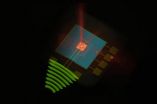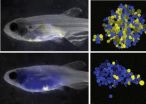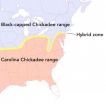(Press-News.org) Flawed but colorful diamonds are among the most sensitive detectors of magnetic fields known today, allowing physicists to explore the minuscule magnetic fields in metals, exotic materials and even human tissue.
University of California, Berkeley, physicist Dmitry Budker and his colleagues at Ben-Gurion University of the Negev in Israel and UCLA have now shown that these diamond sensors can measure the tiny magnetic fields in high-temperature superconductors, providing a new tool to probe these much ballyhooed but poorly understood materials.
"Diamond sensors will give us measurements that will be useful in understanding the physics of high temperature superconductors, which, despite the fact that their discoverers won a 1987 Nobel Prize, are still not understood," said Budker, a professor of physics and faculty scientist at Lawrence Berkeley National Laboratory.
High-temperature superconductors are exotic mixes of materials like yttrium or bismuth that, when chilled to around 180 degrees Fahrenheit above absolute zero (-280ºF), lose all resistance to electricity, whereas low-temperature superconductors must be chilled to several degrees above absolute zero. When discovered 28 years ago, scientists predicted we would soon have room-temperature superconductors for lossless electrical transmission or magnetically levitated trains.
It never happened.
"The new probe may shed light on high-temperature superconductors and help theoreticians crack this open question," said coauthor Ron Folman of Ben-Gurion University of the Negev, who is currently a Miller Visiting Professor at UC Berkeley. "With the help of this new sensor, we may be able to take a step forward."
Budker, Folman and their colleagues report their success in an article posted online Feb. 18 in the journal Physical Review B.
Flawed but colorful
Colorful diamonds, ranging from yellow and orange to purple, have been prized for millennia. Their color derives from flaws in the gem's carbon structure: some of the carbon atoms have been replaced by an element, such as boron, that emits or absorbs a specific color of light.
Once scientists learned how to create synthetic diamonds, they found that they could selectively alter a diamond's optical properties by injecting impurities. In this experiment, Budker, Folman and their colleagues bombarded a synthetic diamond with nitrogen atoms to knock out carbon atoms, leaving holes in some places and nitrogen atoms in others. They then heated the crystal to force the holes, called vacancies, to move around and pair with nitrogen atoms, resulting in diamonds with so-called nitrogen-vacancy centers. For the negatively charged centers, the amount of light they re-emit when excited with light becomes very sensitive to magnetic fields, allowing them to be used as sensors that are read out by laser spectroscopy.
Folman noted that color centers in diamonds have the unique property of exhibiting quantum behavior, whereas most other solids at room temperature do not.
"This is quite surprising, and is part of the reason that these new sensors have such a high potential," Folman said.
Applications in homeland security?
Technology visionaries are thinking about using nitrogen-vacancy centers to probe for cracks in metals, such as bridge structures or jet engine blades, for homeland security applications, as sensitive rotation sensors, and perhaps even as building blocks for quantum computers. Budker, who works on sensitive magnetic field detectors, and Folman, who builds 'atom chips' to probe and manipulate atoms, focused in this work on using these magnetometers to study new materials.
"These diamond sensors combine high sensitivity with the potential for high spatial resolution, and since they operate at higher temperatures than their competitors – superconducting quantum interference device, or SQUID, magnetometers – they turn out to be good for studying high temperature superconductors," Budker said. "Although several techniques already exist for magnetic probing of superconducting materials, there is a need for new methods which will offer better performance."
The team used their diamond sensor to measure properties of a thin layer of yttrium barium copper oxide (YBCO), one of the two most popular types of high-temperatures superconductor. The Ben-Gurion group integrated the diamond sensor with the superconductor on one chip and used it to detect the transition from normal conductivity to superconductivity, when the material expels all magnetic fields. The sensor also detected tiny magnetic vortices, which appear and disappear as the material becomes superconducting and may be a key to understanding how these materials become superconducting at high temperatures.
"Now that we have proved it is possible to probe high-temperatures superconductors, we plan to build more sensitive and higher-resolution sensors on a chip to study the structure of an individual magnetic vortex," Folman said. "We hope to discover something new that cannot be seen with other technologies."
Researchers, including Budker and Folman, are attempting to solve other mysteries through magnetic sensing. For example, they are investigating networks of nerve cells by detecting the magnetic field each nerve cell pulse emits. In another project, they aim at detecting strange never-before-observed entities called axions through their effect on magnetic sensors.
INFORMATION:Coauthors include Amir Waxman, Yechezkel Schlussel and David Groswasser of Ben-Gurion University of the Negev, UC Berkeley Ph.D. graduate Victor Acosta, who is now at Google [x] in Mountain View, Calif., and former UC Berkeley post-doc Louis Bouchard, now a UCLA assistant professor of chemistry and biochemistry.
The work was supported by the NATO Science for Peace program, AFOSR/DARPA QuASAR program, the National Science Foundation and UC Berkeley's Miller Institute for Basic Research in Science.
Colored diamonds are a superconductor's best friend
Flawed but colorful diamonds are sensitive magnetometers for studying magnetic vortices
2014-03-06
ELSE PRESS RELEASES FROM THIS DATE:
Alzheimer's research team employs stem cells to understand disease processes and study new treatment
2014-03-06
Boston, MA – A team of Alzheimer's disease (AD) researchers at Brigham and Women's Hospital (BWH) has been able to study the underlying causes of AD and develop assays to test newer approaches to treatment by using stem cells derived from related family members with a genetic predisposition to (AD).
"In the past, research of human cells impacted by AD has been largely limited to postmortem tissue samples from patients who have already succumbed to the disease," said Dr. Tracy L. Young-Pearse, corresponding author of the study recently published in Human Molecular Genetics ...
E-cigarettes: Gateway to nicotine addiction for US teens, says UCSF study
2014-03-06
E-cigarettes, promoted as a way to quit regular cigarettes, may actually be a new route to conventional smoking and nicotine addiction for teenagers, according to a new UC San Francisco study.
In the first analysis of the relationship between e-cigarette use and smoking among adolescents in the United States, UCSF researchers found that adolescents who used the devices were more likely to smoke cigarettes and less likely to quit smoking. The study of nearly 40,000 youth around the country also found that e-cigarette use among middle and high school students doubled between ...
Up-converted radio
2014-03-06
Ever worry about losing your mobile-phone reception? The problem is a weak microwave signal. The same problem hampers cosmologists looking at the early universe, a glimpse embodied in the cosmic microwave background. Or take a pressing earthly example: oncologists often locate and identify tumors using MRI scans. All three of these efforts---communications, cosmology, medicine---depend on discriminating weak microwave or radio signals from a noisy environment. A new approach to this important problem provides a clean, all-optical detection of microwaves and radiowaves ...
Discovery sheds new light on marijuana's anxiety relief effects
2014-03-06
An international group led by Vanderbilt University researchers has found cannabinoid receptors, through which marijuana exerts its effects, in a key emotional hub in the brain involved in regulating anxiety and the flight-or-fight response.
This is the first time cannabinoid receptors have been identified in the central nucleus of the amygdala in a mouse model, they report in the current issue of the journal Neuron.
The discovery may help explain why marijuana users say they take the drug mainly to reduce anxiety, said Sachin Patel, M.D., Ph.D., the paper's senior ...
Some people really just don't like music
2014-03-06
It is often said that music is a universal language. However, a new report in the Cell Press journal Current Biology on March 6 finds that music doesn't speak to everyone. There are people who are perfectly able to experience pleasure in other ways who simply don't get music in the way the rest of us do.
The researchers refer to this newly described condition as specific musical anhedonia—in other words, the specific inability to experience pleasure from music.
"The identification of these individuals could be very important to understanding the neural basis of music—that ...
'Seeing' bodies with sound (no sight required)
2014-03-06
People born unable to see are readily capable of learning to perceive the shape of the human body through soundscapes that translate images into sound, according to researchers who report their findings in the Cell Press journal Current Biology on March 6. With a little training, soundscapes representing the outlines and silhouettes of bodies cause the brain's visual cortex—and specifically an area dedicated in normally sighted people to processing body shapes—to light up with activity.
With no more than 70 hours of training on average, study participants could recognize ...
Common mutation is culprit in acute leukemia relapse
2014-03-06
Harvard stem cell scientists have identified a mutation in human cases of acute lymphoblastic leukemia that likely drives relapse. The research, published in Cancer Cell, could translate into improved patient care strategies for this particular blood cancer, which typically affects children but is more deadly in adults.
In recent years, a trend toward single-cell analysis has shown that individual cells within a tumor are capable of amassing mutations to make them more aggressive and treatment resistant. So while 99% of a tumor may be destroyed by the initial treatment, ...
Warming temperatures are pushing 2 chickadee species -- and their hybrids -- northward
2014-03-06
The zone of overlap between two popular, closely related backyard birds is moving northward at a rate that matches warming winter temperatures, according to a study by researchers from the Cornell Lab of Ornithology, Villanova University, and Cornell University. The research will be published online in Current Biology on Thursday, March 6, 2014.
In a narrow strip that runs across the eastern U.S., Carolina Chickadees from the south meet and interbreed with Black-capped Chickadees from the north. The new study finds that this hybrid zone has moved northward at a rate ...
Obese adolescents not getting enough sleep?
2014-03-06
Cincinnati, OH, March 6, 2014 -- Lack of sleep and obesity have been associated with an increased risk of cardiovascular and metabolic diseases in adults and young children. However, the association is not as clear in adolescents, an age group that is known to lack adequate sleep and have an overweight and obesity prevalence rate of 30% in the US. In a new study scheduled for publication in The Journal of Pediatrics, researchers found that cardiometabolic risk in obese adolescents may be predicted by typical sleep patterns.
Heidi B. IglayReger, PhD, and colleagues from ...
Establishing standards where none exist; Harvard researchers define 'good' stem cells
2014-03-06
After more than a decade of incremental – and paradigm shifting, advances in stem cell biology, almost anyone with a basic understanding of life sciences knows that stem cells are the basic form of cell from which all specialized cells, and eventually organs and body parts, derive.
But what makes a "good" stem cell, one that can reliably be used in drug development, and for disease study? Researchers have made enormous strides in understanding the process of cellular reprogramming, and how and why stem cells commit to becoming various types of adult cells. But until now, ...
LAST 30 PRESS RELEASES:
Decoupling the HOR enhancement on PtRu: Dynamically matching interfacial water to reaction coordinates
Sulfur isn’t poisonous when it synergistically acts with phosphine in olefins hydroformylation
URI researchers uncover molecular mechanisms behind speciation in corals
Chitin based carbon aerogel offers a cleaner way to store thermal energy
Tracing hidden sources of nitrate pollution in rapidly changing rural urban landscapes
Viruses on plastic pollution may quietly accelerate the spread of antibiotic resistance
Three UH Rainbow Babies & Children’s faculty elected to prestigious American Pediatric Society
Tunnel resilience models unveiled to aid post-earthquake recovery
Satellite communication systems: the future of 5G/6G connectivity
Space computing power networks: a new frontier for satellite technologies
Experiments advance potential of protein that makes hydrogen sulfide as a therapeutic target for Alzheimer’s disease
Examining private equity’s role in fertility care
Current Molecular Pharmacology achieves a landmark: real-time CiteScore advances to 7.2
Skeletal muscle epigenetic clocks developed using postmortem tissue from an Asian population
Estimating unemployment rates with social media data
Climate policies can backfire by eroding “green” values, study finds
Too much screen time too soon? A*STAR study links infant screen exposure to brain changes and teen anxiety
Global psychiatry mourns Professor Dan Stein, visionary who transformed mental health science across Africa and beyond
KIST develops eco-friendly palladium recovery technology to safeguard resource security
Statins significantly reduce mortality risk for adults with diabetes, regardless of cardiovascular risk
Brain immune cells may drive more damage in females than males with Alzheimer’s
Evidence-based recommendations empower clinicians to manage epilepsy in pregnancy
Fungus turns bark beetles’ defenses against them
There are new antivirals being tested for herpesviruses. Scientists now know how they work
CDI scientist, colleagues author review of global burden of fungus Candida auris
How does stroke influence speech comprehension?
B cells transiently unlock their plasticity, risking lymphoma development
Advanced AI dodel predicts spoken language outcomes in deaf children after cochlear implants
Multimodal imaging-based cerebral blood flow prediction model development in simulated microgravity
Accelerated streaming subgraph matching framework is faster, more robust, and scalable
[Press-News.org] Colored diamonds are a superconductor's best friendFlawed but colorful diamonds are sensitive magnetometers for studying magnetic vortices




